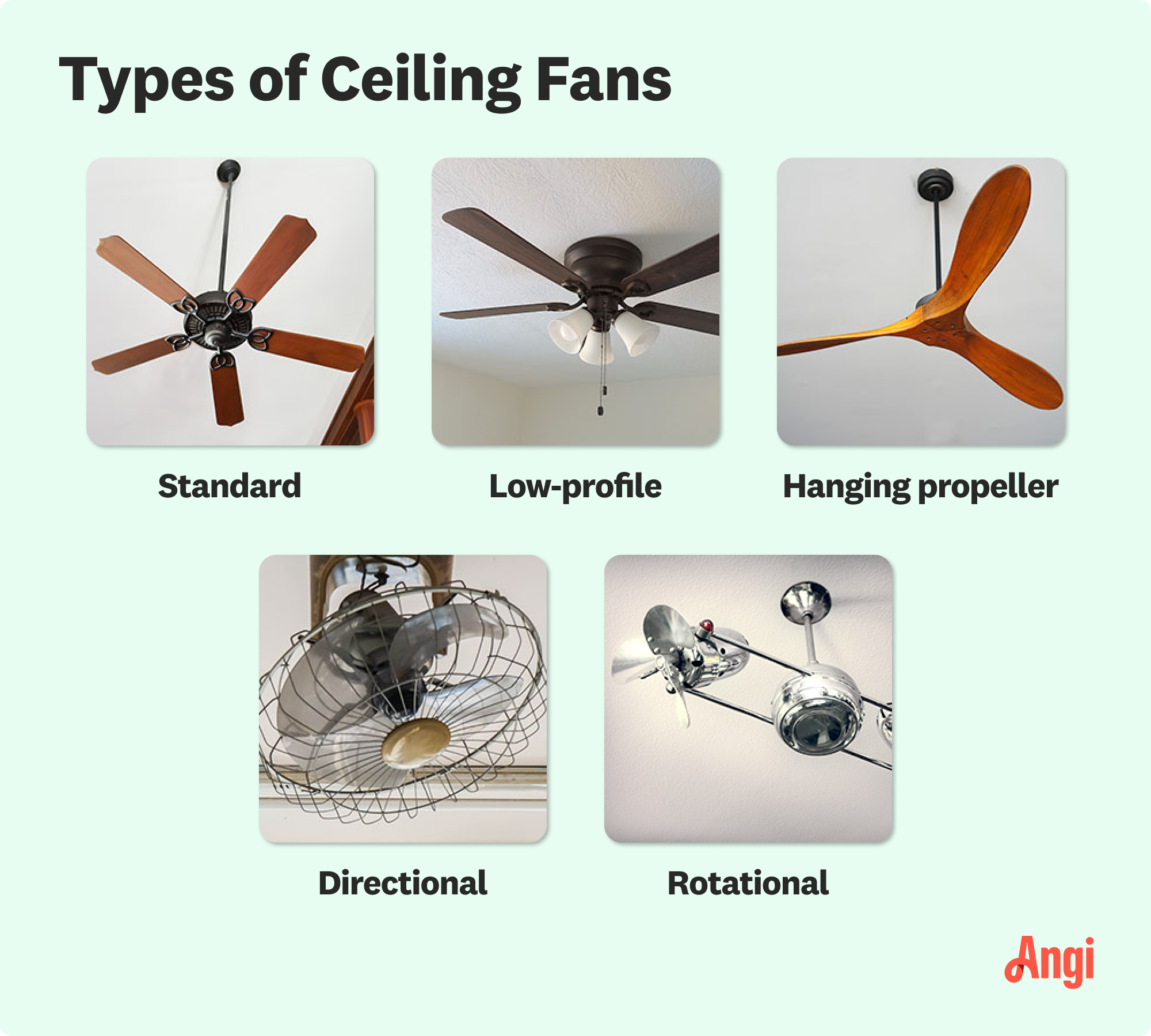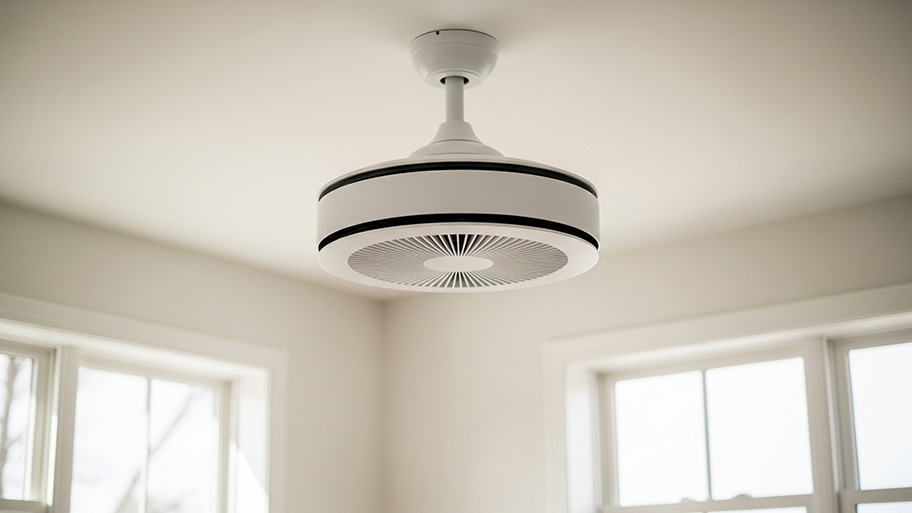
If your ceiling fan stops working due to a bad motor or broken pull chain, here’s what you can expect to pay to get it fixed.
The cost to install a ceiling fan ranges from $145 to $355, with most homeowners paying an average of $250. Key factors include fan type, installation complexity, and labor rates.


The cost to install a ceiling fan depends on fan size, type, installation complexity, and labor.
Professional installation costs $50 to $130 per hour and ensures safe wiring and compliance with local electrical codes.
Upgrading wiring can increase installation costs by $5 to $17 per square foot.
A well-chosen ceiling fan can enhance home appeal and offer a return on investment through energy savings.
This article was created using automation technology and thoroughly fact-checked and edited by an Angi Editor in accordance with our AI policy.
The cost to install a ceiling fan averages $250, with an average range from $145 to $355 depending on fan type, labor, and installation complexity. Homeowners may pay as little as $85 for a basic replacement or up to $644 for high-end models or complex installs.
Ceiling fans are a practical upgrade for comfort and energy savings. This guide breaks down what impacts the cost to install a ceiling fan, so you can plan confidently and avoid unexpected expenses.
Understanding the factors that influence the cost to install a ceiling fan helps you budget and plan. Fan type, labor, permits, added features, and unique project needs all play a role.
The type of ceiling fan you choose significantly affects the purchase price and installation cost.

| Fan Type | Description | Average Cost | Pros | Cons |
|---|---|---|---|---|
| Standard | Basic, indoor, 3–5 blades | $150–$400 | Affordable, easy to install | Fewer features |
| Low-profile/hugger | Sits close to ceiling, for low ceilings | $150–$400 | Good for low ceilings | Lower airflow |
| ENERGY STAR | Energy-efficient, lower operating cost | $200–$500 | Saves energy, may qualify for rebates | Higher upfront cost |
| With lighting | Includes integrated light kit | $200–$450 | Dual purpose, saves space | More wiring, higher cost |
| Smart | Wi-Fi, app, or voice control | $250–$600 | Convenience, automation | More complex install |
| Outdoor/wet-rated | For porches, patios, damp/wet locations | $200–$600 | Weather-resistant | Needs special hardware |
Standard ceiling fans are the most common and cost-effective, while specialty fans with advanced features or custom finishes are more expensive.
Low-profile or hugger fans are designed for rooms with low ceilings and may require less complex installation. ENERGY STAR-rated fans and models with integrated LED lighting can help you save on operating costs, though they may increase upfront costs. Smart ceiling fans with remote, app, or voice controls require more complicated wiring and setup.
Outdoor and wet/damp-rated fans are built to withstand the elements and often need special installation steps or hardware. Designer or specialty fans, such as those with dual motors or retractable blades, are visually striking but tend to be more expensive to buy and install.
Choosing the right size ceiling fan for your space is an important step toward a successful installation. Blade span, or the diameter from blade tip to tip, not only affects airflow but also impacts installation cost. Larger fans require more support and time to install, especially in big rooms or high ceilings.
Small fans, usually 29 to 36 inches, fit well in compact rooms like bathrooms or offices and are the most affordable to install. Standard fans, measuring 42 to 52 inches, suit most bedrooms and living spaces. Oversized fans, 60 inches or larger, are ideal for great rooms, vaulted ceilings, or outdoor spaces and often require reinforced mounting or additional labor.
Fans with greater blade spans may need extra hardware or a second installer for safety. Specialty or designer fans for large or unique spaces can also increase overall installation costs.
| Fan Blade Span (Inches) | Average Cost (Fan Only) |
|---|---|
| 29–36 | $50–$300 |
| 42–52 | $100–$500 |
| 60+ | $150–$600 |
In-home location matters when determining the cost to install your fan. Standard bedrooms and living rooms are usually straightforward, but vaulted ceilings, outdoor spaces, or hard-to-reach areas require more labor and sometimes special equipment.
Hiring a professional is the safest route for ceiling fan installation. Electricians charge $50 to $130 per hour, while handypeople or general contractors may charge slightly less but may not handle complex wiring. Most professionals charge a flat rate per fan, but some bill hourly, especially for complicated jobs.
Labor costs are lower for replacing an existing fan or light fixture. New installations needing wiring, ceiling reinforcement, or high-reach equipment cost more. Labor includes mounting the fan, wiring, testing for safe operation, and post-installation cleanup.
A permit is often required for new ceiling fan installations, especially if new wiring or structural changes are involved. Permit fees range from $20 to $100, depending on your municipality. Some areas require a final inspection, which may add another $25 to $75. The electrician you hire usually obtains and includes permit costs in their quote. Skipping required permits can result in fines or insurance problems if something goes wrong.
Upgrading your ceiling fan with features like remote controls, wall switches, or smart controls increases installation complexity and cost. Specialty mounting hardware—like adapters for sloped ceilings or extra-long downrods—may cost $10 to $50 more. Decorative elements or custom finishes can also push up the price, as can upgrading to energy-efficient or smart models.
Project complexity is a major driver. New installations, especially in rooms without existing ceiling fixtures, require new wiring ($5 to $17 per square foot) and potentially a new electrical circuit ($150 to $600), which increases labor and material costs. High ceilings, attic access, or obstacles like beams add time and expense.
Site preparation—such as removing an old fan or fixture—may be included or billed separately. Delivery and disposal fees, design or consultation charges for custom installs, and inspection costs (if required) all add up. Structural reinforcement may be needed for heavy or oversized fans, and electrical panel upgrades are sometimes necessary for older homes.
Beyond installation, there are ongoing and one-time costs to factor into your ceiling fan budget.
Most ceiling fans come with a manufacturer’s warranty covering parts, the motor, and sometimes finishes for one to five years. Extended warranties, available from retailers or installers, cost $20 to $100 and may add labor coverage. A good warranty can reduce long-term repair or replacement costs, especially for higher-end fans.
Ceiling fans are energy-efficient, using 15 to 90 watts per hour—far less than air conditioning. Operating a fan costs an average of $5 to $20 per year, depending on usage and local electricity rates. ENERGY STAR models save even more. Using integrated lighting increases annual costs, especially with incandescent bulbs, so opt for LED lights when possible.
Routine maintenance involves cleaning blades, tightening screws, and occasionally lubricating the motor. DIY maintenance costs little, while professional maintenance visits run $50 to $150 per year. Common ceiling fan repairs—such as fixing a wobble, replacing a switch, or addressing motor issues—range from $50 to $400. DIY repairs save money but require caution and proper tools.
Sales tax applies to ceiling fan purchases and, in some states, to installation labor. Rates vary by state and locality, ranging from 5% to 10% on average. Be sure to factor this into your total project budget.
Homeowner’s insurance may require that electrical work be performed by a licensed professional. DIY installation can void coverage if an electrical fire or injury occurs due to improper work. Professional installation helps maintain insurance protection and reduces liability risks.
Some homeowners consider installing a ceiling fan themselves to save on labor. DIY installation costs the price of the fan plus $10 to $40 for materials like wire connectors, mounting brackets, and tools if you do not already own them. The main savings come from skipping professional labor fees.
However, DIY installation requires electrical skills, comfort working on a ladder, and the ability to follow safety protocols. The risk of improper wiring, unstable mounting, or voiding warranties is real. For complex installs, high ceilings, or locations without existing wiring, it is best to hire a licensed electrician.
When a ceiling fan fails, you will need to decide whether to repair or replace it. Common repairs include fixing wobbly blades, replacing pull switches, or repairing the motor. These repairs range from $50 to $400. If your fan is under warranty, repairs may be covered.
If your fan is more than 10 years old or repairs exceed 50% of the cost of a new fan, replacement makes more sense. Major failures, like a burned-out motor or damaged housing, often require a full replacement. When replacing, consider recycling your old fan to reduce environmental impact.
Installing a ceiling fan can offer a solid return on investment. Ceiling fans improve comfort, reduce reliance on HVAC systems, and lower energy bills by up to 8% per year. Homebuyers appreciate the added comfort and efficiency, making rooms feel more inviting.
Compared to other upgrades like lighting or HVAC improvements, ceiling fans are a cost-effective way to enhance room functionality and aesthetics. Modern fans with smart features, energy efficiency, and stylish designs further increase your home’s appeal and value.
Consider these cost-saving strategies to make your ceiling fan installation more budget-friendly:
Get multiple quotes from local ceiling fan installers to compare rates.
Choose a fan that fits your needs and budget.
Install during off-peak seasons for potential discounts.
Consider replacing an existing fan to save on wiring costs.
Bundle multiple installations for volume pricing.
Purchase the fan and materials yourself to avoid markup.
Opt for standard models over custom or designer fans.
Perform simple prep work (making the area accessible or removing an old fan) yourself.
Home is the most important place on earth, which is why Angi has helped more than 150 million homeowners transform their houses into homes they adore. To help homeowners with their next project, Angi provides readers with the most accurate cost data and upholds strict editorial standards. We extensively research project costs to develop the pricing data you see, so you can make the best decisions for you and your home. We rely on reputable sources, including the U.S. Bureau of Labor Statistics, academic journals, market studies, and interviews with industry experts—all to ensure our prices reflect real-world projects.
Want to help us improve our cost data? Send us a recent project quote to [email protected]. Quotes and personal information will not be shared publicly.
From average costs to expert advice, get all the answers you need to get your job done.

If your ceiling fan stops working due to a bad motor or broken pull chain, here’s what you can expect to pay to get it fixed.

Are traditional ceiling fans slowly becoming a thing of the past? The famously quiet and efficient bladeless fans are now appearing right above our heads.

Looking to cool down a room or get some more air flowing throughout the house? Learn how to install a ceiling fan without existing wiring.

Most ceiling fans should be reasonably quiet most of the time. Learn why your ceiling fan is making noise and how you can fix these common problems

Ceiling fans need the help of lubrication to run smoothly and quietly. Learn how to oil a ceiling fan without taking it down in a few simple steps.

Removing a ceiling fan is an easy task that any handy DIYer can tackle. Follow the five steps in this guide to learn how to remove a ceiling fan.